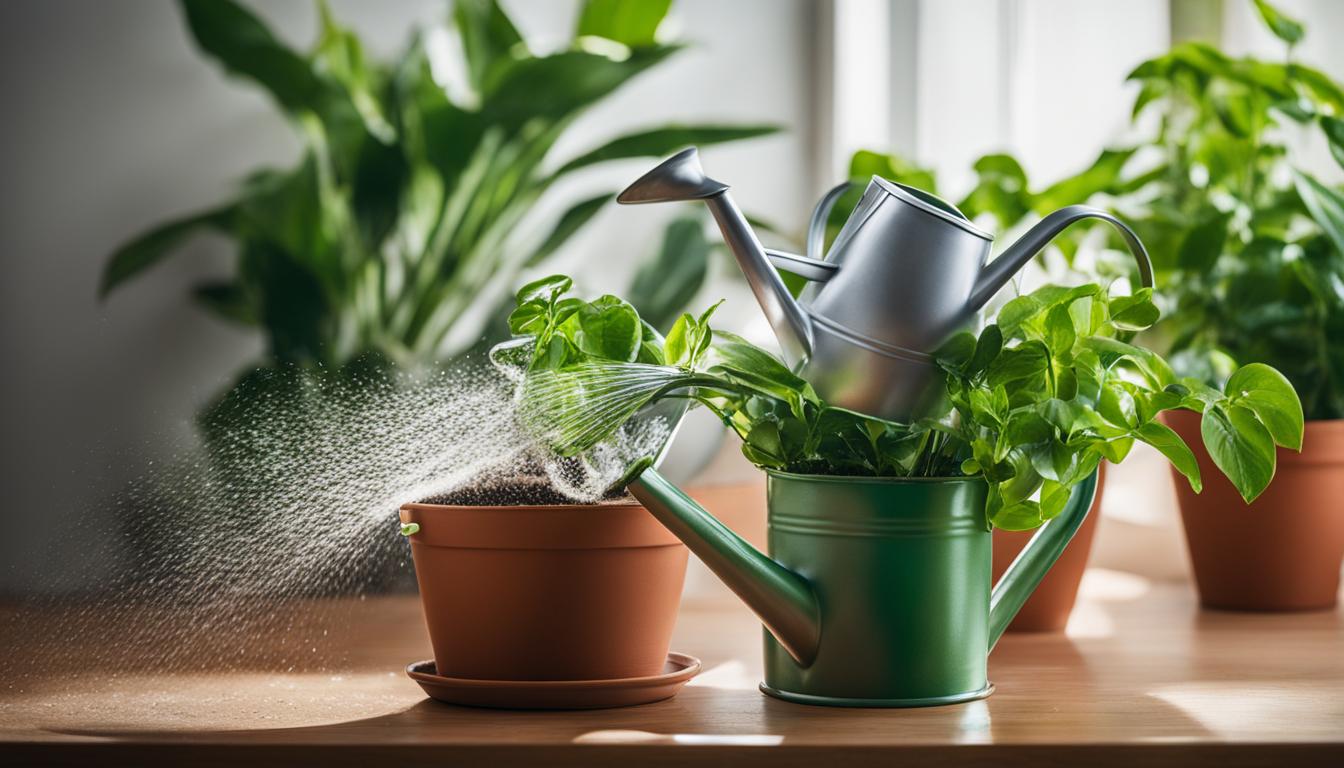
Indoor plants bring beauty and fresh air to our homes, but yellow leaves can be a frustrating issue. Fortunately, there are several ways to prevent and address this problem, ensuring your plants stay healthy and vibrant.
By understanding the common causes of yellow leaves and implementing proper care techniques, you can maintain the lush growth of your indoor plants.
Key Takeaways:
- Proper watering is crucial for preventing yellow leaves in indoor plants. Pay attention to signs of dehydration and overwatering.
- Providing optimal light conditions for your indoor plants is essential. Different plants have varying sunlight requirements.
- Maintaining humidity levels can prevent moisture loss in plant leaves, which can lead to yellowing.
- Addressing pest infestations promptly is important to avoid yellow leaves. Regular inspections and natural remedies can help eliminate pests.
- Ensuring adequate nutrient levels through proper fertilization can prevent nutrient deficiencies and yellowing leaves in indoor plants.
Common Causes of Yellow Leaves in Indoor Plants
Yellow leaves in indoor plants can be a sign of various underlying issues. Understanding the common causes of yellowing leaves is crucial for maintaining the health and vibrancy of your indoor garden. Let’s explore the primary factors that contribute to yellow leaves in indoor plants.
Overwatering
One of the most common causes of yellow leaves is overwatering. When plants are overwatered, the roots become waterlogged, leading to root rot and nutrient imbalances.
The excess moisture prevents the roots from absorbing oxygen and nutrients efficiently, resulting in yellowing leaves.
Underwatering
Conversely, underwatering can also cause yellow leaves. When indoor plants don’t receive enough water, they become dehydrated, and the lack of moisture hampers their ability to perform essential functions. This can lead to nutrient deficiencies and ultimately result in yellowing leaves.
Nutrient Deficiencies
Yellow leaves can also indicate nutrient deficiencies in indoor plants. Lack of essential nutrients like nitrogen or iron can impair the plant’s ability to carry out crucial metabolic processes. As a result, the leaves may turn yellow as the plant reallocates resources to more vital areas.
Pests
Pest infestations can damage the foliage of indoor plants, causing yellow leaves. Common pests like mealybugs and spider mites feed on plant tissues, extracting vital nutrients and damaging the structure. This can lead to discoloration and yellowing of the leaves.
Lack of Light
Insufficient light is another culprit behind yellow leaves in indoor plants. Plants need an adequate amount of light to carry out photosynthesis, which is essential for their growth and overall health. When plants don’t receive enough light, they may develop yellow leaves as a sign of stress.
Cold Drafts
Exposure to cold drafts can also contribute to yellowing leaves in indoor plants. Sudden temperature drops and drafts can shock the plant and disrupt its metabolic processes. This can lead to yellowing leaves and other signs of stress.
To prevent yellow leaves in indoor plants, it’s important to address the underlying causes. By providing proper watering, sufficient light, and a conducive environment, you can maintain the health and vibrant foliage of your indoor plants.
Proper Watering for Indoor Plants
Proper watering is essential for maintaining the health and vitality of indoor plants. By understanding the signs of dehydration and overwatering, as well as implementing effective watering techniques, you can prevent yellow leaves and promote optimal growth.
Signs of dehydration in indoor plants include wilting leaves and dry soil. When you notice these signs, it’s crucial to water your plants thoroughly.
Use a watering can or a hose with a gentle flow to ensure that the water reaches the roots. Also, make sure to water until the excess water drains out of the bottom of the pot, ensuring proper hydration.
On the other hand, signs of overwatering, such as waterlogged soil or a moldy smell, indicate that you may be watering your plants too frequently.
Overwatering can lead to root rot and other issues, resulting in yellow leaves. To address this, it’s important to allow the soil to dry out slightly between waterings. Inserting your finger about an inch into the soil can help determine if it’s time to water again.
Watering Techniques
Proper watering techniques can help prevent both dehydration and overwatering. Here are some tips to keep in mind:
- Water your indoor plants at a consistent schedule, taking into account their specific needs. Some plants may require more frequent watering, while others may prefer a drier environment.
- Use room temperature water for watering, as cold water can shock the roots and affect the plant’s overall health.
- Avoid watering the leaves of your plants, as this can lead to fungal diseases. Instead, focus on watering the soil directly at the base of the plant.
- Consider using a moisture meter, which can help you accurately determine the moisture level in the soil and guide your watering routine.
By following these proper watering techniques and paying attention to the signs of dehydration and overwatering, you can ensure that your indoor plants receive the right amount of water and maintain vibrant, green foliage.
Optimal Light Conditions for Indoor Plants
Providing optimal light conditions is essential for the health and growth of indoor plants. Different plants have varying sunlight requirements, and understanding these needs is key to ensuring their vitality.
Let’s explore the importance of light exposure, the types of plants that thrive in different light conditions, and how to best meet their requirements.
Sunlight Requirements
Indoor plants fall into two broad categories when it comes to light exposure: light-loving plants and low light plants. Light-loving plants, such as succulents and tropical species, require direct sunlight for a significant portion of the day.
Placing them near windows or in sun-drenched areas of your home will ensure they receive the necessary light to thrive. On the other hand, low light plants, including ferns and snake plants, are more resilient in shaded conditions. These plants can tolerate indirect or filtered light and are well-suited for rooms with limited natural light.
Maximizing Light Exposure
To maximize light exposure for indoor plants, consider the orientation of your windows and the natural light patterns in your home. South-facing windows typically receive the most sunlight throughout the day, making them ideal for light-loving plants.
East-facing windows receive gentle morning light, while west-facing windows offer brighter afternoon light. North-facing windows provide the most subdued light and are suitable for low light plants.
By placing your plants accordingly, you can optimize their exposure to natural light and prevent yellow leaves caused by insufficient light.
| Light-loving Plants | Low Light Plants |
|---|---|
| Succulents | Ferns |
| Tropical species | Snake plants |
To further enhance light conditions for indoor plants, you can also use artificial lighting. LED grow lights are an excellent option as they provide the right spectrum of light needed for plant growth.
Positioning the lights close to the plants and adjusting the duration and intensity of the light will mimic natural sunlight and promote healthy foliage. Regularly monitoring your plants’ growth and adjusting the lighting accordingly will help provide optimal light conditions and prevent yellow leaves.
Maintaining Humidity Levels for Healthy Indoor Plants
Proper humidity levels are essential for the health and vitality of indoor plants. Maintaining the right level of indoor humidity can prevent yellow leaves and promote lush growth. Here are some effective methods to maintain optimal humidity for your indoor plants:
- Plant Misting: One way to increase humidity is through plant misting. Using a spray bottle, gently mist the leaves of your indoor plants. This helps create a microclimate around the plants, providing the necessary moisture for healthy growth. Misting is particularly beneficial for plants that require higher humidity levels.
- Humidity Trays: Another method is to use humidity trays. These trays are filled with water and placed beneath the plant pots. As the water evaporates, it increases the humidity around the plants. This is especially helpful for plants that prefer moderate levels of humidity.
It’s important to monitor the humidity levels in your home and adjust these methods accordingly to meet the specific needs of your indoor plants.
This can be done using a hygrometer, which measures the moisture content in the air. Aim for humidity levels between 40% and 60% for most indoor plants.
Preventing Excessive Humidity
While maintaining the right humidity is crucial, it’s equally important to avoid excessive humidity, which can lead to issues like mold and fungal growth. Here are some tips to prevent excessive humidity:
- Avoid overwatering your plants, as this can increase humidity levels.
- Provide proper ventilation in the room where your plants are located to prevent stagnant air and excess moisture buildup.
- Use a dehumidifier if necessary to reduce humidity levels in your home.
| Plant | Ideal Humidity Level |
|---|---|
| Monstera | 40% – 60% |
| Ferns | 50% – 60% |
| Orchids | 50% – 70% |
| Cacti and Succulents | 30% – 40% |
Keep in mind that different plants have varying humidity requirements. The table above provides general guidelines for popular indoor plant varieties. It’s important to research the specific needs of your plants to ensure they receive the appropriate humidity levels for optimal growth.
Addressing Indoor Plant Pests and Yellow Leaves
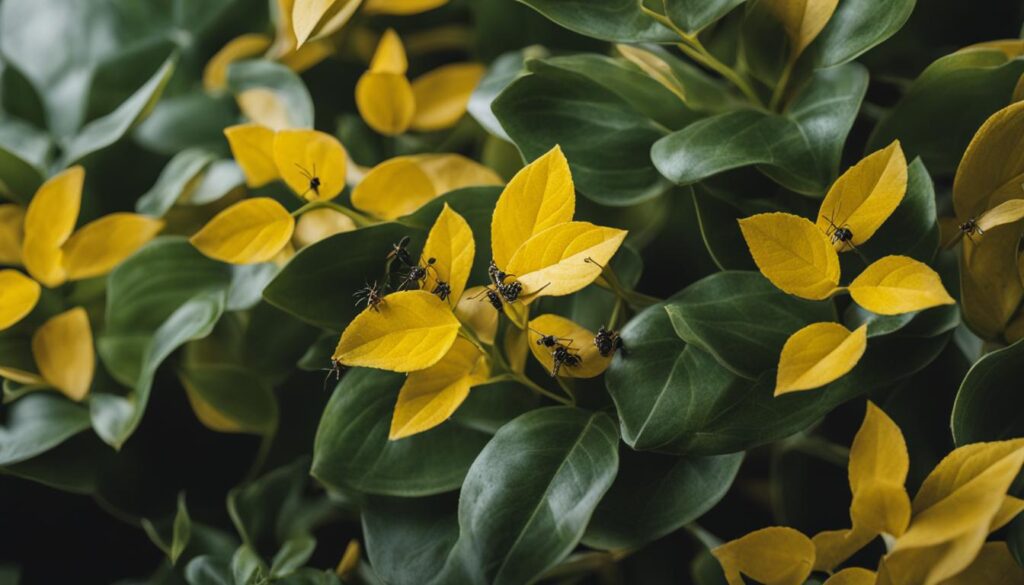
Indoor plant pests can be a nuisance and can also contribute to the development of yellow leaves. It’s important to identify and address these pests promptly to prevent further damage to your plants.
Common indoor plant pests include mealybugs, spider mites, aphids, and fungus gnats. These pests can cause discoloration, stunted growth, and even plant death if left untreated.
There are several methods of pest control that can help eliminate these pests and restore the health of your indoor plants. One natural remedy is to use insecticidal sprays, which are specifically designed to target and kill common indoor plant pests.
Neem oil is another effective natural remedy that works by suffocating pests and disrupting their life cycle.
When using insecticidal sprays or neem oil, it’s important to follow the instructions carefully to ensure safe and effective application.
Regularly inspecting your plants for signs of pests and implementing proper pest control measures can help prevent infestations and the development of yellow leaves.
Remember to isolate any infected plants to prevent the spread of pests to other healthy plants in your indoor garden.
| Pest | Description | Control Methods |
|---|---|---|
| Mealybugs | Small, soft-bodied insects covered in a white, waxy substance. They feed on plant sap and can cause yellowing leaves. | Remove mealybugs manually with a cotton swab dipped in rubbing alcohol. Apply insecticidal soap or neem oil to control infestations. |
| Spider Mites | Microscopic pests that are difficult to see with the naked eye. They suck plant juices and cause yellow speckles on leaves. | Isolate infected plants and apply a strong spray of water to dislodge spider mites. Use insecticidal soap or neem oil to control severe infestations. |
| Aphids | Small insects that come in a variety of colors. They feed on plant sap and can cause curling or yellowing of leaves. | Remove aphids manually with a cotton swab dipped in soapy water. Use insecticidal soap or neem oil for severe infestations. |
| Fungus Gnats | Small black flies that are attracted to damp soil. Their larvae feed on plant roots, leading to yellowing leaves and stunted growth. | Allow the soil to dry out between waterings to discourage fungus gnat larvae. Use sticky traps or beneficial nematodes to control adult fungus gnats. |
By actively addressing indoor plant pests and implementing effective pest control methods, you can prevent the development of yellow leaves and keep your indoor plants healthy and vibrant.
Nutrient Deficiencies and Yellow Leaves
Nutrient deficiencies can be a common cause of yellow leaves in indoor plants. Two of the most significant nutrient deficiencies that can lead to yellowing leaves are nitrogen deficiency and iron deficiency.
- Nitrogen deficiency: When a plant lacks nitrogen, its older leaves often turn yellow. Nitrogen is essential for plant growth and is required for the production of chlorophyll, which gives leaves their green color. Without sufficient nitrogen, plants struggle to produce enough chlorophyll, resulting in yellowing leaves.
- Iron deficiency: Iron is another crucial nutrient for plants. When plants lack iron, their new leaves may turn yellow. Iron is involved in the production of chlorophyll and plays a role in the transport of electrons during photosynthesis. Without enough iron, plants cannot produce chlorophyll effectively, leading to yellow leaves.
Addressing nutrient deficiencies in indoor plants is important to prevent yellow leaves and promote overall plant health. Fertilizers can be used to supplement the nutrient levels in the soil and provide the necessary elements for plant growth.
It’s essential to choose a fertilizer that is specifically formulated for indoor plants and follow the recommended feeding rates. By ensuring plants have access to an adequate supply of nutrients, you can help prevent nutrient deficiencies and keep your indoor plants vibrant and healthy.
| Nutrient Deficiency | Signs | Treatment |
|---|---|---|
| Nitrogen | Yellowing of older leaves | Apply a nitrogen-rich fertilizer according to package instructions |
| Iron | Yellowing of new leaves | Use an iron supplement or apply iron chelate to the soil |
Best Practices for Indoor Plant Maintenance
When it comes to maintaining healthy indoor plants and preventing yellow leaves, following some best practices is essential. Regular inspections, cleaning leaves, pruning, repotting, and avoiding over-crowding are key aspects of proper indoor plant maintenance.
Regular Inspections
Regularly inspecting your indoor plants is crucial for identifying any early signs of issues such as pests, diseases, or nutrient deficiencies.
Look for any discoloration, spots, or abnormal growth on the leaves, stems, or roots. By catching problems early on, you can take prompt action and prevent further damage.
Cleaning Leaves
Cleaning the leaves of your indoor plants helps remove dust and debris, allowing them to better absorb sunlight for photosynthesis.
Gently wipe the leaves with a damp cloth or use a gentle spray of water to keep them clean and dust-free. This simple practice can improve the overall health and appearance of your plants.
Pruning
Regular pruning is necessary to remove any dead, damaged, or yellowing leaves. Additionally, pruning can help shape the plant and encourage new growth.
Use clean, sharp pruning shears to make clean cuts just above a leaf node or bud. Be cautious not to remove too much foliage at once, as it can stress the plant.
Repotting
Repotting indoor plants is essential to provide them with fresh soil and adequate drainage. Over time, plants outgrow their pots, leading to root-bound conditions.
Repotting allows for healthier root growth and prevents over-crowding. When repotting, choose a pot that is slightly larger than the current one and use a well-draining potting mix.
Avoiding Over-Crowding
Over-crowding can lead to competition for resources and hinder the growth of your indoor plants. Ensure that each plant has enough space to grow and receive adequate light and airflow.
If necessary, consider repositioning or propagating some of your plants to maintain a healthy and balanced indoor garden.
By following these best practices for indoor plant maintenance, you can provide optimal care for your plants and prevent yellow leaves.
Remember to inspect your plants regularly, clean their leaves, prune when necessary, repot as needed, and avoid over-crowding. These simple steps will help keep your indoor garden thriving and vibrant.
Troubleshooting Yellow Leaves in Indoor Plants
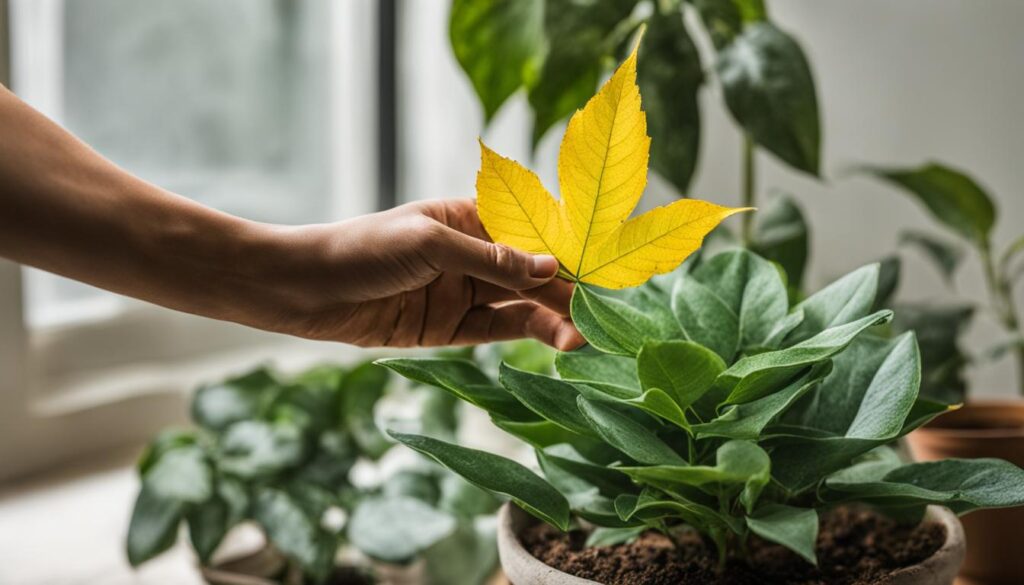
When faced with yellow leaves on your indoor plants, it’s important to diagnose the underlying issues in order to effectively address the problem.
This step-by-step guide will help you identify and resolve the common causes of yellowing leaves, including moisture stress, pest infestations, light and temperature issues, and nutrient deficiencies.
Diagnosing Plant Issues
Start by examining the overall health of your indoor plants. Look for signs of pests, such as webs, sticky residue, or visible insects. Inspect the leaves for discoloration, spots, or unusual patterns.
Consider the watering habits and light exposure of your plants, as these factors can also contribute to yellow leaves. Taking note of these observations will help you narrow down the potential causes and guide your troubleshooting process.
Moisture Stress
Moisture stress can occur from both overwatering and underwatering. Check the moisture levels of the soil by inserting your finger about an inch deep. If the soil feels dry, it may indicate that the plant needs watering.
But, if the soil feels excessively wet or soggy, it may be a sign of overwatering. Adjust your watering schedule accordingly, allowing the soil to dry out slightly between waterings. Ensure that your plants have proper drainage to prevent waterlogged soil and root rot.
Pest Infestations
Pests like spider mites, mealybugs, and aphids can damage plant tissues and cause yellowing leaves. Inspect both the upper and lower surfaces of the leaves for signs of insects or eggs.
If found, promptly treat the infestation with appropriate measures, such as using insecticidal sprays or natural remedies like neem oil. Regularly monitoring and addressing pest issues will help keep your indoor plants healthy and prevent yellowing leaves.
Light and Temperature Issues
Insufficient or excessive light exposure, as well as extreme temperature fluctuations, can negatively impact the health of indoor plants. Ensure that your plants are placed in locations that receive the appropriate amount of light for their specific needs.
Light-loving plants may require direct sunlight, while low light plants thrive in shaded areas. Additionally, avoid exposing your plants to cold drafts or extreme temperature changes, as this can stress the leaves and lead to yellowing.
Nutrient Deficiencies
Nutrient deficiencies, such as lack of nitrogen or iron, can cause yellowing leaves in indoor plants. Consider fertilizing your plants with appropriate nutrient blends to address these deficiencies.
Follow the recommended feeding rates and choose fertilizers that are specifically formulated for indoor plants. Providing the necessary nutrients will help promote healthy growth and prevent yellow leaves caused by nutrient deficiencies.
After exploring the common causes of yellow leaves in indoor plants and learning about effective care techniques, it’s clear that preventing yellow leaves requires attention to detail and regular maintenance.
By implementing these healthy indoor plant care tips, you can maintain vibrant, green foliage in your indoor garden.
Regular inspections of your plants will help you identify any issues early on, whether it’s pest infestations, moisture stress, or nutrient deficiencies.
Adjusting your watering techniques to provide adequate hydration without overwatering is crucial. Additionally, placing your plants in optimal light conditions and maintaining humidity levels will contribute to their overall health.
Addressing any pest issues promptly and providing the right nutrients through fertilizers will help prevent yellow leaves and promote healthy growth.
Finally, following best practices such as regular cleaning, pruning, and repotting will ensure that your indoor plants thrive.
In conclusion, by combining these preventive measures and implementing proper care techniques, you can enjoy a beautiful indoor garden with lush, green plants and avoid the frustration of yellow leaves.
Remember to observe your plants closely, adjust your care routine as needed, and provide them with the optimal conditions to flourish.
FAQ
What are the common causes of yellow leaves in indoor plants?
The common causes of yellow leaves in indoor plants include overwatering, underwatering, nutrient deficiencies, pests, lack of light, and exposure to cold drafts.
How can I prevent yellow leaves in my indoor plants?
To prevent yellow leaves, make sure to properly water your plants, provide optimal light conditions, maintain humidity levels, address pest issues, and ensure adequate nutrient levels.
How do I know if my indoor plants are dehydrated or overwatered?
Signs of dehydration include wilting or dry soil, while signs of overwatering include waterlogged soil or a moldy smell. Adjust your watering frequency based on these signs.
How do I choose the right location for my indoor plants based on light requirements?
Light-loving plants need direct sunlight, while low light plants can thrive in shaded areas. Observe the light exposure in your home and place plants accordingly.
How can I maintain humidity levels for healthy indoor plants?
You can mist your plants regularly, use humidity trays filled with water, or place plants together to create a microclimate with higher humidity.
What can I do to address pests that are causing yellow leaves in my indoor plants?
Identify the specific pest and implement appropriate pest control measures like insecticidal sprays or neem oil. Regularly inspect and treat your plants for pests.
How can I address nutrient deficiencies that are causing yellow leaves in my indoor plants?
Use fertilizers with the appropriate nutrients and follow recommended feeding rates. Choose the right fertilizer for your plant’s needs and apply it accordingly.
What are the best practices for maintaining healthy indoor plants?
Regularly inspect plants for signs of pests, diseases, or nutrient deficiencies. Clean plant leaves to remove dust and debris, prune to remove damaged leaves, and repot plants with fresh soil and adequate drainage.
How can I troubleshoot yellow leaves in my indoor plants?
Diagnose the specific issues causing yellowing leaves, such as moisture stress, pest infestations, light and temperature issues, and nutrient deficiencies. Address each issue accordingly.
What are the key takeaways for preventing yellow leaves in indoor plants?
By following proper care techniques, including regular inspections, proper watering, optimal light conditions, maintaining humidity levels, addressing pests, and providing adequate nutrients, you can prevent yellow leaves and maintain healthy indoor plants.

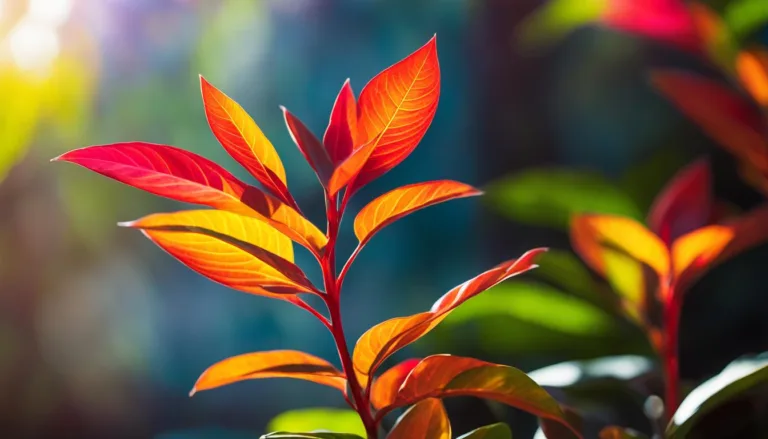
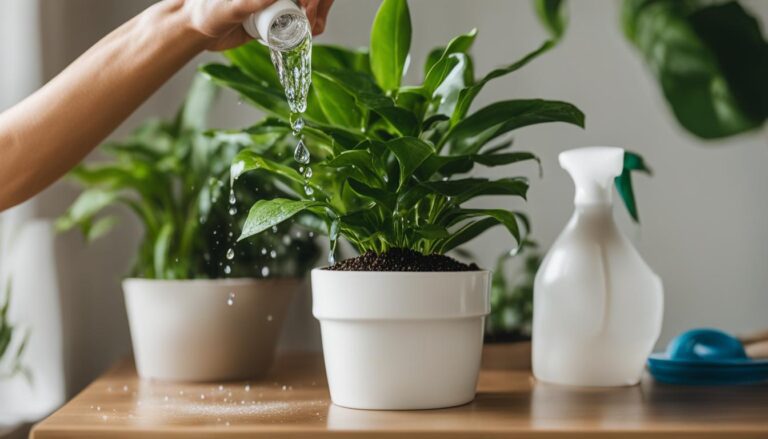
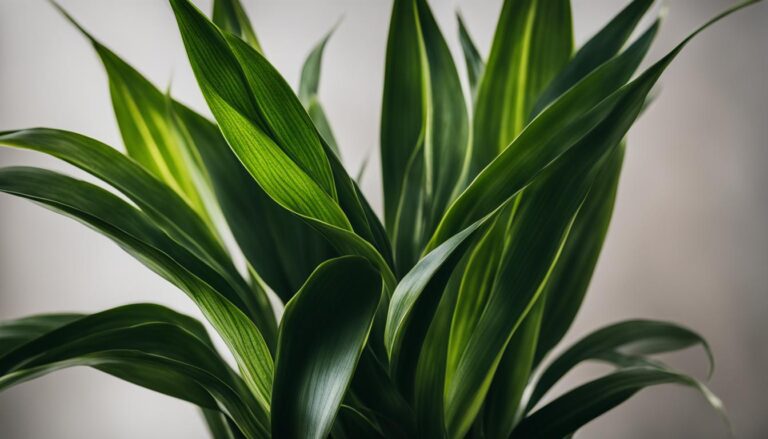
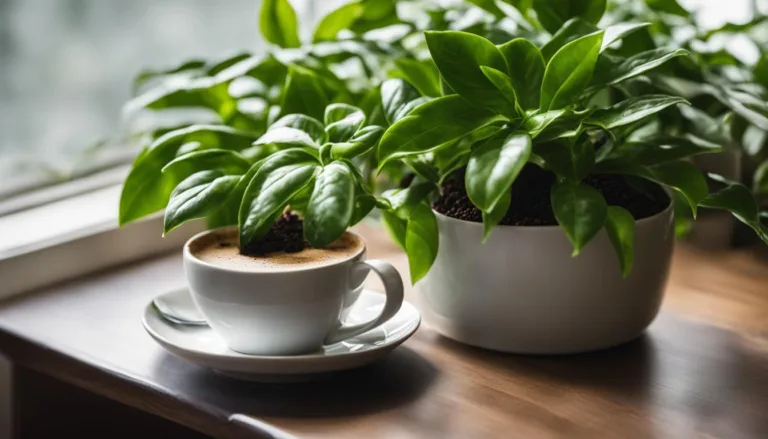
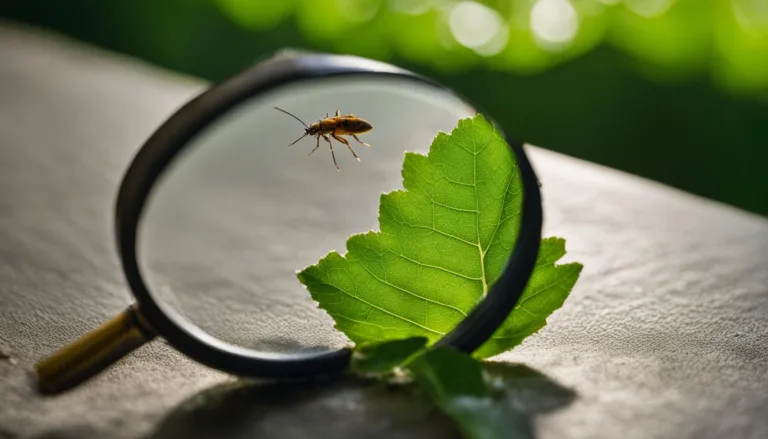
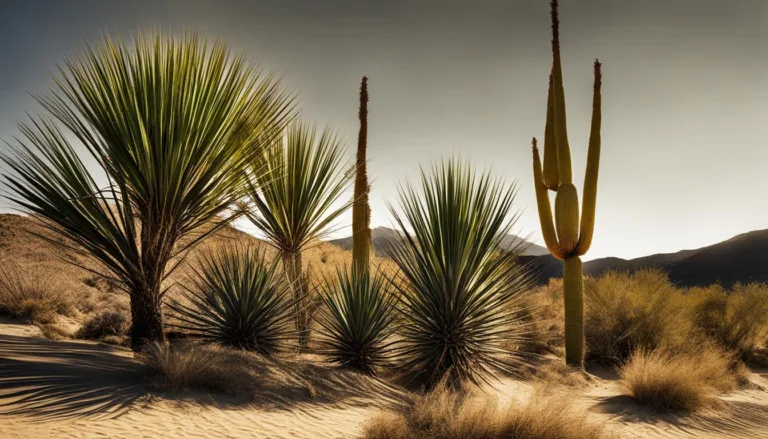
2 Comments
Comments are closed.